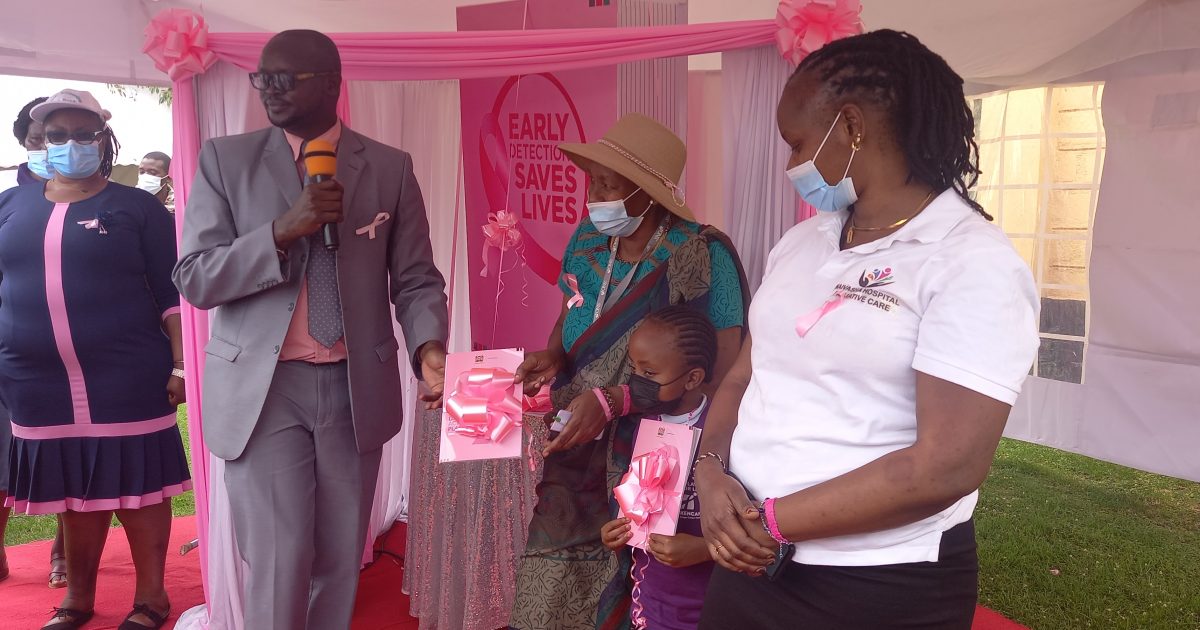The Ag. Director General for Health Dr Patrick Amoth has urged Kenyans to go for early cancer screening and treatment as a way of winning the war against the disease.
Dr Amoth said there was need to bridge the gap between screening and medication, noting that while a mere 13.6 percent of Kenyans were screened for breast cancer in the past one month, 70 percent of cancer cases in the country are diagnosed late when nothing much can be done.
The Ag. Director General made remarks in a speech read on his behalf by Head of Inter-Governmental and International Health relations at the Ministry of Health, Dr Lenai Kamario during the launch of Breast Cancer Awareness Action Plan 2021/2025 at the Nakuru Level 5 Teaching and Referral hospital.
The statistics from the Ministry of Health also rank cancer as the third leading high mortality disease in Kenya, followed by infectious diseases, with cervical cancer listed as the top cause of death among women followed by breast, uterine and oesophagus cancers.
The statistics indicate that about 6,000 new cases of breast cancer are reported every year in the country.
Dr Amoth said the government had developed policy guidelines aimed at reducing the prevalence of breast cancer in the eligible population by 50 percent by the year 2025, through regular screening, early diagnosis and treatment.
“In 2019, Kenya registered 2,553 deaths with the number rising to 3,157 deaths in 2020 as a result of breast cancer. This type of cancer also afflicts men and is most common in women between the ages of 35-45years,” stated the Acting Director General.
He noted that the Ministry was strengthening the capacity of health care workers to screen and detect precancerous cells.
Dr Amoth revealed that the government had developed National Cancer Guidelines aimed at improving accuracy of screening and diagnosis of the disease at both the county and national levels.
Meanwhile, an average of 48,000 cases of cancer was being recorded in the country annually leading to 34,000 deaths.
On his part, Dr Kamario who was flanked by Nakuru Level 5 Hospital Superintendent, Dr Aisha Maina, noted data from the Ministry of Health department indicated that fewer men compared to women are checked for cancer.
Dr Maina asserted that most cancers were treatable if diagnosed early, while calling on Kenyans to change their perception of the disease as a death sentence.
He revealed that more Kenyan women die from cancer than men, according to the World Health Organization’s research agency.
The medical superintendent said 600 patients out of 2,000 diagnosed with breast cancer in the past eight months at the Nakuru-Level 5 Hospital’s Oncology unit, had fully recovered after completing their treatment sessions.
She said the national uptake of screening stands at 16 per cent which was far way below the figure recommended to fight cancer effectively.
“Cancer accounts for seven per cent of annual deaths in Kenya and is now a common illness. Cervical cancer, second most common, can be prevented through vaccination. Each one of us can play a role in reducing the impact of cancer. This is a disease that can be managed if detected early. It is not a death sentence,” noted the medical superintendent.
At the same time, statistics from the health department, according to Dr Maina, indicated that the leading cancer reported in men within the devolved unit was prostrate, while throat and eye cancer were common in children.
She also encouraged parents to take their 10-year-old girls for the Human Papillomavirus (HPV) vaccine to prevent cervical cancer.
Dr Maina disclosed that the cervical cancer screening services remain available in all public health facilities within the devolved unit and appealed to all eligible women to visit their nearest health facilities for screening at least once a year.
Meanwhile, the International Agency for Research on Cancer’s Globocan data shows that the disease claims 18,772 women countrywide compared to 14,215 men yearly. Women also lead in new cancer cases with 28,688 getting the disease compared to 19,199 men, representing 56 per cent of the total new cases.
In the next five years, the Globocan data projects that Kenyan women will continue bearing the brunt as cancer rates are set to rise twice faster than in men.
Since the Oncology centre was established at the Nakuru Level Six Hospital four years ago, more than 35,000 cases have been reviewed out of which over 6,000 have undergone chemotherapy.
Prior to the establishment of the department, patients in need of cancer treatment were referred to Kenyatta National Hospital in Nairobi and Moi Teaching and Referral Hospital in Eldoret.
Dr Maina said there was a glimmer of hope for patients requiring Radiotherapy sessions who have to travel to Nairobi, as the Nakuru county administration has started construction of a Sh500 Million Radiotherapy Centre.
By Jane Ngugi and David Opingo




